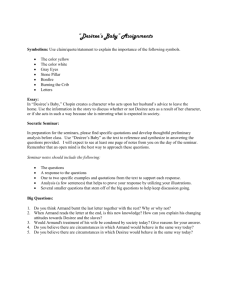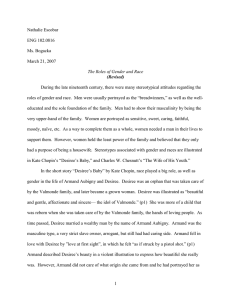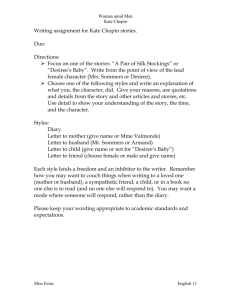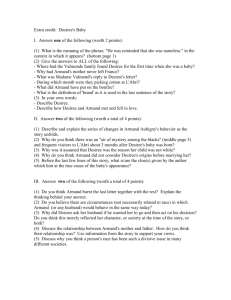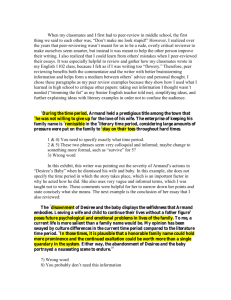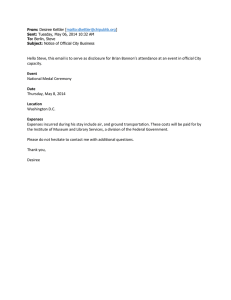Nathalie Escobar ENG102.0816 Ms. Bogacka March 21, 2007
advertisement
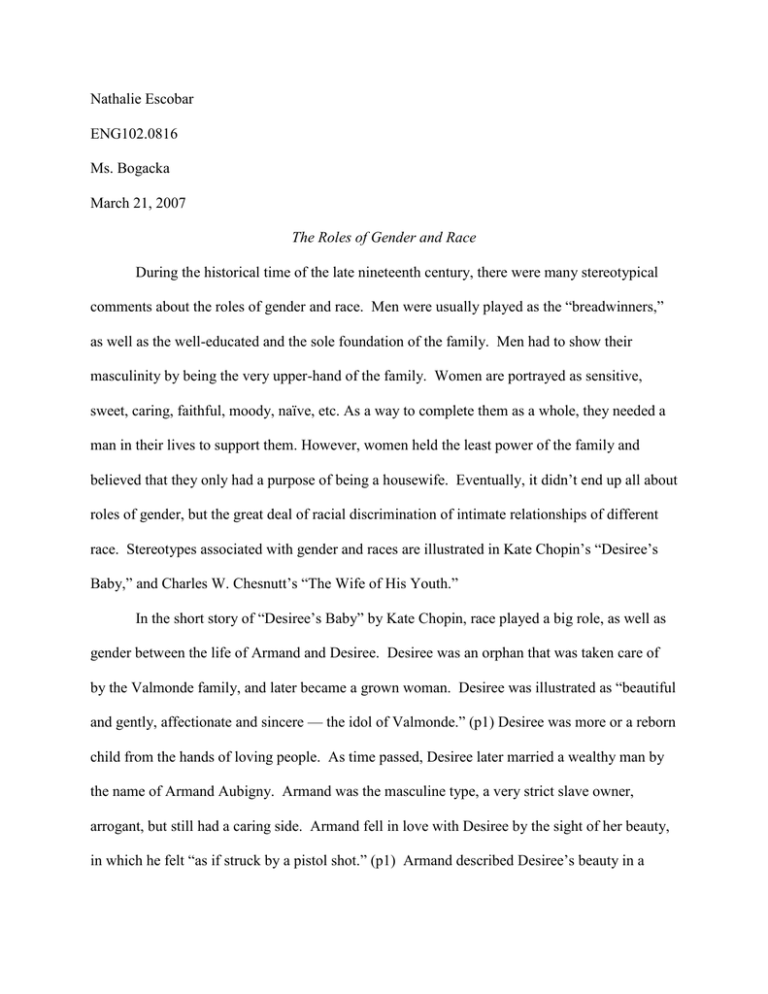
Nathalie Escobar ENG102.0816 Ms. Bogacka March 21, 2007 The Roles of Gender and Race During the historical time of the late nineteenth century, there were many stereotypical comments about the roles of gender and race. Men were usually played as the “breadwinners,” as well as the well-educated and the sole foundation of the family. Men had to show their masculinity by being the very upper-hand of the family. Women are portrayed as sensitive, sweet, caring, faithful, moody, naïve, etc. As a way to complete them as a whole, they needed a man in their lives to support them. However, women held the least power of the family and believed that they only had a purpose of being a housewife. Eventually, it didn’t end up all about roles of gender, but the great deal of racial discrimination of intimate relationships of different race. Stereotypes associated with gender and races are illustrated in Kate Chopin’s “Desiree’s Baby,” and Charles W. Chesnutt’s “The Wife of His Youth.” In the short story of “Desiree’s Baby” by Kate Chopin, race played a big role, as well as gender between the life of Armand and Desiree. Desiree was an orphan that was taken care of by the Valmonde family, and later became a grown woman. Desiree was illustrated as “beautiful and gently, affectionate and sincere — the idol of Valmonde.” (p1) Desiree was more or a reborn child from the hands of loving people. As time passed, Desiree later married a wealthy man by the name of Armand Aubigny. Armand was the masculine type, a very strict slave owner, arrogant, but still had a caring side. Armand fell in love with Desiree by the sight of her beauty, in which he felt “as if struck by a pistol shot.” (p1) Armand described Desiree’s beauty in a violent illustration to express how beautiful she really is. However, Armand did not care of what origin she derived from and in which he had portrayed her as “nameless,” (p1) like Desiree was some kind of possession. Both Armand and Desiree later started a family and had baby that was a boy. The baby, in which Desiree thought to bring the family closer with love, had brought consequences to the family. The love that they shared had turned against her as she faces racial discrimination from her own husband. At first, Armand was happy to hear the great news that he has a son to carry out his name, but when he closely looked at the color of the child’s skin he immediately rejected Desiree and his child. Armand, as a slave owner, felt like it would be a disgrace to his family’s name and to people if they were to find out he was to have a colored child of his own. In addition to having a colored child, others would look at him differently because he has a colored child while he treats the slaves that are colored very cruel. During the whole marriage, Desiree finally ends in a downfall in which she leaves Armand with the baby, but leaves a letter for Armand of the truth. He finds out from the letter reading the letter, “…Armand will never know that his mother, who adores him, belongs to the race that is cursed with the brand of slavery.” (p4) In “The Wife of His Youth” by Charles W. Chesnutt, there were many stereotypical views on race and gender that took place while equality was slowly forming among races of different color. Mr. Ryder, a freeborn, light-colored skin complexion and well-educated man wanted to be equal in society; therefore he joined an organization called “The Blue Veins.” The Blue Veins was a society for exclusive people, which mostly consisted of light-colored skin members and of wealthy people. Mr. Ryder proved to be a person that struggled to achieve a better life and future. However, Mr. Ryder in the past was also known as Sam Taylor. As Sam Taylor, he worked on a plantation as an apprentice. He was considered not a slave because he was born free, but his “master” wanted to sell him as a slave to make more money. (p5) Therefore, Sam Taylor fled from the plantation but left behind his slave marriage that was with an older woman by the name of Liza Jane. Before he left, he promised to come back for Liza Jane and that they both would reunite. Except, he eventually went to find her but she was no longer working in the plantation in which he gave up and started a new chapter in his life. Eventually, a woman came to his door; she was described as a little woman, quite old, had many wrinkles, very black, etc (p4). This woman was illustrated as an old fashion, southern plantation woman. She introduced herself to Mr. Ryder as Liza Jane, and traveled from afar to look for her long lost husband for over twenty years. Liza told her whole life story about herself and the husband she faithfully was searching for to Mr. Ryder. In a way, Mr. Ryder tried to diverge a way out of the conversation with Liza Jane because he didn’t want her to find out that Sam Taylor, was himself. After the conversation, Mr. Ryder continued his plan of making a ball to propose to a woman he was attracted to, Mrs. Dixon. During the ball, Mr. Ryder proposed a toast to the women in the ball about a story that was truly based on his life. He wanted an opinion based acceptance from his fellow members of the society, if he was to marry a colored woman. The close members of his society agreed to Mr. Ryder that “he should acknowledge her.” As mostly everyone agreed, he told the members that the story was about him, and he brought out his wife which was Liza Jane. It was a difficult situation for Mr. Ryder to decide because his past life as Sam Taylor, he didn’t have many choices available on what to do with his life than as of now, as Mr. Ryder. Sam Taylor, was a freeborn, apprentice that worked in a plantation and was about to be sold as a slave by his master. He had no other choice but to leave the plantation and his slave marriage with Liza Jane. Liza was unable to join Sam because she was a cook of the family that owned the plantation and a slave. Sam had no choice but to start a new life and try to educate himself to be successful. As a way to keep the slave marriage alive, he kept a promise with her that he would come back for her. Now as a freeborn, Sam Taylor become well-educated and slowly became a wealthy man, he then changed his name to Mr. Ryder. Mr. Ryder had more choices in his life because he became the dean of “The Blue Veins” and was wealthy. He was light-colored and was equally acknowledge by the white people and other light-colored people. He was a well respected man, had a good life in which he was able to support himself, and a “ladies’ man.” Mr. Ryder had better opportunities and a better future than the life of Sam Taylor.

